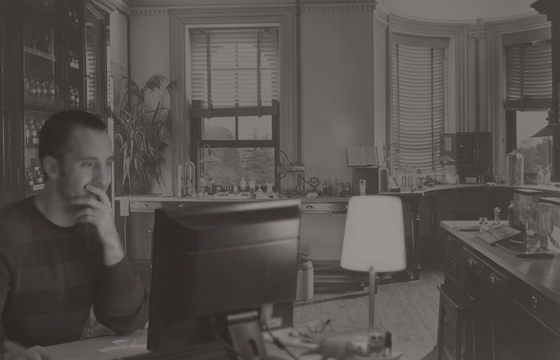
Here I am blogging…in our “lab.”
Many of our agency friends have been blogging for a few years now, but it’s been about as effective a strategy as attending a networking mixer; most companies know instinctively that they need to be there, but they just don’t know exactly why, what they will bring to the conversation, or what they’ll do with the experience. As a result, many agency blogs are pretty unfocused. Some are mostly “neat stuff” aggregators, while others are “innovationspeak” engines running on the Taco Bell model—you know, same words, different combinations. Few actually know what they’re about.
This month’s upcoming newsletter is going to be about how to improve your blog—make it accurately represent your firm, educate your prospects, and generate new interest in what you offer. In the meantime though, I’ve been thinking about a way that some agencies have used their blog that I call the “mad scientist” strategy. Let me explain…
The Iceberg Theory

This image comes from my presentation on writing for business called Professional Writing
for the Unprofessional Writer.
First, I need to apply the iceberg theory—the idea that good writing should only reveal about one eighth of a writer’s knowledge of the subject—to your blogging strategy. Peter Turchi, in his book, Maps of the Imagination: The Writer as Cartographer, quotes Hemingway on the concept of the “literary” iceberg:
I always try to write on the principle of the iceberg. There is seven-eighths of it underwater for every part that shows… If a writer of prose knows enough about what he is writing about he may omit things that he knows and the reader, if the writer is writing truly enough, will have a feeling of all those things as strongly as though the writer had stated them… [But] if a writer omits something because he does not know it then there is a hole in the story.
– ERNEST HEMINGWAY
A corporate blog should reinforce this idea. I believe that the value of a blog is in the long-term relationship that is built between it’s author and readers. Blogs take a cumulative approach to tell an ongoing story with many short posts. They are relational. When someone subscribes to a blog, they are making a commitment to getting to know you—one they can break at any point (and are likely to) when a blog loses or never develops focus. The story that is told by a blog, though, is one that, when looked at in retrospect, leaves an impression of the writer’s interest and expertise on the reader. At any point in time, I can look at some of the blogs I read regularly and have a sense for who the authors are and what they’re about. The seven eighths of the “iceberg” are in that impression, while the one eighth is in each individual post. This is why a blog that is focused tightly by a firm’s positioning will be more effective that a “generalist” blog. It will slowly describe that positioning through posts that cover thoughts about practice, new ideas, application of expertise, and the like.
But What About…?
There is an exception to this; you may already be thinking of one. What about those bloggers that write so often that their blog is more of a written document of their thinking—as expansive of or peripheral to their core discipline as it may be—than a deliberately considered marketing tool? There are many, many bloggers like this; you might describe their blogs as “unfocused.” In fact, the blogs I look forward to reading most are blogs of this kind. But that’s because they are focused, just not in an immediately discernible way. I call the authors of these blogs “mad scientists” because their creative license, freedom to experiment and ask “dumb” questions, latitude, and diversity of content reinforce my perception of them as profound thinkers, which in turn reinforces my trust in the quality of their firm’s work. They probably don’t talk about work they’ve done as much as work they want to do. They probably talk about tomorrow more than yesterday. They don’t use much marketing language. And they never try to sell “innovation.” But their writing definitely fills in the unseen seven eighths of their firm’s “iceberg.”
Design is one of those disciplines that must aggregate knowledge from a wide range of other disciplines in order to properly inform its execution. In turn, good designers are deep thinkers and lifelong students of other areas of knowledge. So it tends to be the case that every good firm has a “mad scientist” on staff, either in a particular person or personified by a stated and supported core value of practice. This person’s thinking influence the kind of client a firm attracts, the kind of work it does, and the kind of people that come there to work. A person who fits this description should probably be one of your active bloggers because the ongoing story they tell will be an extremely valuable one to the perception of your firm as a thoughtful, cutting edge practice with a vision to guide its clients into the future.
Examples
Here are a few people I read that fit in with the “mad scientist” description (in no particular order other than how they come up in my feed reader): David Sherwin, Jack Cheng, Michael Surtees, Paul Isakson, Eric Karjaluoto, Russell Davies, Jonathan Harris, Emmett Connolly, Michael Babwahsingh, Steven Frank, and Craig Mod.



